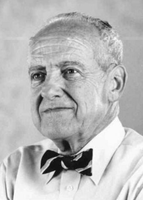










Nathaniel C. Wyeth was an American mechanical engineer and inventor. He is best known for creating polyethylene terephthalate that could withstand the pressure of carbonated liquids. Made of recyclable PET plastic, lighter than glass and virtually unbreakable, Wyeth's invention is used widely today for both carbonated and non-carbonated drinks.
A member of the famous artistic family, Nathaniel Wyeth stood out by becoming an engineer and inventor. Born in Chadds Ford, Pennsylvania, Nat was the sonof famed illustrator N. C. Wyeth, who constantly encouraged his children todevelop and express their imaginations. While brother Andrew and three sisters flourished artistically and musically, Nat dismantled clocks and transformed them into toy speedboat engines. Far from disapproving, N. C. early on suspected his son's talents would lie in engineering and changed the boy's givenname from Newell Convers (N. C.'s own name) to Nathaniel, the name of an uncle who was an engineer. N. C. recruited another uncle to survey colleges whereNat could receive good technical training. Nat attended the uncle's choice,the University of Pennsylvania, graduating with a B.S. in 1936. During his college years, Wyeth designed and built a 20-foot hydroplane.
Upon graduating, Wyeth worked briefly for the Delco company in Ohio and thenjoined Du Pont as a field engineer. He remained at Du Pont for the rest of his career, and was eventually named the company's first senior engineering fellow. After designing a new valve for a production machine, Wyeth was transferred to the mechanical development laboratory, where he was able to devote himself to engineering design and invention. One of his first projects was an automatic dynamite-cartridging machine; a later one was a bonding machine to produce a polypropylene fabric called Typar used as a backing material on rugs.
Wyeth's most famous invention was the plastic soda pop bottle. Wyeth became curious about why plastic was not being used for carbonated beverages, and found out that when plastic was molded into bottles, certain parts of the bottlewere weaker than others and could not withstand the carbonation pressure. Adopting a stretching technique used to strengthen nylon fibers, Wyeth startedexperimenting with cold-stretching plastic molecules. He devised a way to extrude the plastic with crisscrossed flow lines, which reinforced themselves and created a uniformly strong bottle. The plastic he was using, however, was not self-balancing--it kept stretching in one direction until it burst. He switched to polyethylene terephthalate, or PET, which stretched in one place when the limit was reached somewhere else. The result was the first successful plastic soda pop bottle, patented in 1973, and now the industry standard. Wyeth retired from Du Pont in 1976. He died in 1990 in Glen Cove, Maine, the holder of 25 patents.